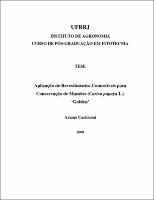| Compartilhamento |


|
Use este identificador para citar ou linkar para este item:
https://tede.ufrrj.br/jspui/handle/tede/555Registro completo de metadados
| Campo DC | Valor | Idioma |
|---|---|---|
| dc.creator | Castricini, Ariane | pt_BR |
| dc.creator.Lattes | http://lattes.cnpq.br/1141604492412599 | por |
| dc.contributor.advisor1 | Coneglian, Regina Celi Cavestré | pt_BR |
| dc.contributor.advisor1Lattes | http://buscatextual.cnpq.br/buscatextual/visualizacv.do?id=K4768689D9 | por |
| dc.contributor.advisor-co1 | Deliza, Rosires | pt_BR |
| dc.contributor.advisor-co1Lattes | http://buscatextual.cnpq.br/buscatextual/visualizacv.do?id=K4787393T4 | por |
| dc.date.accessioned | 2016-04-28T14:59:00Z | - |
| dc.date.available | 2010-09-21 | pt_BR |
| dc.date.issued | 2009-02-16 | pt_BR |
| dc.identifier.citation | CASTRICINI, Ariane. Aplicação de revestimentos comestíveis para conservação de mamões (Carica papaya L.) Golden. 2009. 128 f. Tese (Doutorado em Fitotecnia) - Instituto de Agronomia Universidade Federal Rural do Rio de Janeiro, Seropédica, 2009. | por |
| dc.identifier.uri | https://tede.ufrrj.br/jspui/handle/tede/555 | - |
| dc.description.resumo | O presente trabalho foi conduzido na UFRRJ (avaliações físicas, químicas e microbiológicas) e na Embrapa Agroindústria de Alimentos (análise sensorial), com o objetivo geral de avaliar a influência de atmosfera modificada por revestimentos de amido (fécula de mandioca e amido modificado) sobre o amadurecimento e conservação de mamões (Carica papaya L.) Golden , armazenados em ambiente refrigerado. Os revestimentos foram utilizados nas concentrações de 1%, 3% e 5%. As concentrações de fécula de mandioca a 3 e 5% proporcionaram melhores resultados, quanto ao amadurecimento. Retardaram o desenvolvimento da coloração amarela da casca, porém não permitiu o desenvolvimento total da mesma e mantiveram os frutos firmes por mais tempo, durante o período experimental. As taxas respiratórias foram menores quanto maior a concentração dos revestimentos. O revestimento a 1% foi suficiente para reduzir as taxas respiratórias dos frutos, mas não influenciou positivamente nas demais variáveis estudadas. Os revestimentos favoreceram maior integridade das paredes celulares, evidenciada pela boa estruturação e organização das mesmas assim como visualização da lamela média. Já aqueles de amido modificado não foram eficientes na prevenção do amadurecimento. Os resultados de acidez total titulável, teor de ácido ascórbico e sólidos solúveis totais foram semelhantes aqueles dos frutos não revestidos. As taxas respiratórias foram menores nos frutos revestidos pelas películas a 3 e 5%, mas não o suficiente para desacelerar o processo de amadurecimento, durante o armazenamento. A visualização microscópica das paredes celulares revelaram boa integridade nos frutos com películas revestimentos a 1 e 5% e evidenciou desestruturação quando revestidos a 3%. Os revestimentos de fécula de mandioca e amido modificado afetaram mais os atributos de aparência que o sabor dos frutos. A película de fécula de mandioca a 5% foi mais adequada para o revestimento dos frutos, considerando a maioria dos atributos de aparência estudados. Porém, o descascamento evidenciado pela menor integridade da mesma, foi considerado desfavorável. O revestimento por amido modificado e fécula de mandioca a 1% formaram películas íntegras, ou seja, sem descascamento. O sabor foi pouco influenciado pelos revestimentos, mas o revestimento de amido modificado a 5% alterou o sabor característico de mamão, evidenciado pelo gosto amargo percebido aos 12 e 14º dias de armazenamento. Os revestimentos de fécula de mandioca com e sem tratamento fitossanitário favoreceram o desenvolvimento das podridões pós-colheita, em relação às películas de amido modificado. Porém as maiores áreas afetadas pelas lesões foi observada somente nos frutos revestidos pelas concentrações de 3 e 5% de fécula de mandioca após o tratamento fitossanitário. Embora os óleos tenham inibido o crescimento de Colletotrichum gloeosporioides in vitro , não foram eficientes no controle quando adicionados aos revestimentos. Devido ao cheiro forte do óleo de bulbilho de alho e casca de canela deixaram no fruto, além das manchas do óleo de canela, tornam-se esses produtos inadequados para uso em pós-colheita. | por |
| dc.description.abstract | This study was conducted in UFRRJ (physico, chemical and microbiological analysis) and Embrapa Agroindústria de Alimentos (sensory evaluation), with the general objective of assessing the influence of modified atmosphere by coating of starch (cassava starch and modified starch) on the ripening and conservation of papayas (Carica papaya L.) Golden , stored in refrigerated environment. The coating were used in concentrations of 1%, 3% and 5%. The concentrations of cassava starch to 3 and 5% provided better results as ripening: it s delayed the development of color yellow skin but without total development of yellow color and the fruits remained firm for a longer time, during the experimental period. The respiratory rates were lower as higher as the concentration of the coating. The coating of 1% was sufficient to reduce the respiratory rate of fruits, but not positively influenced by other variables. The coatings favored greater integrity of cell walls, demonstrated the proper structure and organization of the same view as the middle lamella. Coatings of modified starch were not effective in preventing ripeness. It did not cause distinct changes in titratable acidity, the content of ascorbic acid and total soluble solids. The results were similar those of uncoated fruits. The respiratory rates were lower in fruits coated film for the 3 and 5%, but not enough to slow the ripening process during storage. The microscopic visualization of cell walls showed good integrity in fruits coated film by the 1 and 5% and evidence of destruction when coated to 3%. The coatings of cassava starch and modified starch affect more the attributes of appearance that the taste of fruits. The coating of cassava starch at 5% was suitable for coating fruits, whereas the majority of the attributes of appearance studied. However, the stripping evidenced by the lower integrity of it, was considered unfavorable. The coating of modified starch and cassava starch at 1% formed intact film, without peeling. The taste was somewhat influenced by the coatings, but the coating of modified starch and 5% changed the characteristic flavor of papaya, evidenced by the bitter taste perceived at 12 and 14 days of storage. The coating of cassava starch with and without sanitary treatment plant favored the development of post-harvest decay, for the film of modified starch. But the largest areas affected by the lesions were observed only in fruits coated by concentrations of 3 and 5% of cassava starch after sanitary treatment plant. The oil inhibited the growth of Colletotrichum gloeosporioides in vitro, but when added to the coatings were not effective in controlling decay. For the sake of strong smell of garlic and cinnamon bark oils left in the fruits, beyond stains caused by concentrations of 1 and 0.5% oil of cinnamon, these products were improper to post-harvest use. | eng |
| dc.description.provenance | Made available in DSpace on 2016-04-28T14:59:00Z (GMT). No. of bitstreams: 1 2009 - Ariane Castricini.pdf: 2010336 bytes, checksum: 05cebf92245d2829733f92cab21a0901 (MD5) Previous issue date: 2009-02-16 | eng |
| dc.description.sponsorship | Fundação Carlos Chagas Filho de Amparo a Pesquisa do Estado do Rio de Janeiro - FAPERJ | pt_BR |
| dc.format | application/pdf | por |
| dc.thumbnail.url | https://tede.ufrrj.br/retrieve/14599/2009%20-%20Ariane%20Castricini.pdf.jpg | * |
| dc.thumbnail.url | https://tede.ufrrj.br/retrieve/18697/2009%20-%20Ariane%20Castricini.pdf.jpg | * |
| dc.thumbnail.url | https://tede.ufrrj.br/retrieve/24980/2009%20-%20Ariane%20Castricini.pdf.jpg | * |
| dc.thumbnail.url | https://tede.ufrrj.br/retrieve/31373/2009%20-%20Ariane%20Castricini.pdf.jpg | * |
| dc.thumbnail.url | https://tede.ufrrj.br/retrieve/37767/2009%20-%20Ariane%20Castricini.pdf.jpg | * |
| dc.thumbnail.url | https://tede.ufrrj.br/retrieve/44171/2009%20-%20Ariane%20Castricini.pdf.jpg | * |
| dc.thumbnail.url | https://tede.ufrrj.br/retrieve/50531/2009%20-%20Ariane%20Castricini.pdf.jpg | * |
| dc.thumbnail.url | https://tede.ufrrj.br/retrieve/57013/2009%20-%20Ariane%20Castricini.pdf.jpg | * |
| dc.language | por | por |
| dc.publisher | Universidade Federal Rural do Rio de Janeiro | por |
| dc.publisher.department | Instituto de Agronomia | por |
| dc.publisher.country | Brasil | por |
| dc.publisher.initials | UFRRJ | por |
| dc.publisher.program | Programa de Pós-Graduação em Fitotecnia | por |
| dc.rights | Acesso Aberto | por |
| dc.subject | Carica papaya L. | por |
| dc.subject | fécula de mandioca | por |
| dc.subject | amido modificado | por |
| dc.subject | cassava starch | eng |
| dc.subject | modified starch | eng |
| dc.subject.cnpq | Agronomia | por |
| dc.title | Aplicação de revestimentos comestíveis para conservação de mamões (Carica papaya L.) Golden | por |
| dc.title.alternative | Application of edible coating to papaya (Carica papaya L.) Golden conservation | eng |
| dc.type | Tese | por |
| Aparece nas coleções: | Doutorado em Fitotecnia | |
Arquivos associados a este item:
| Arquivo | Descrição | Tamanho | Formato | |
|---|---|---|---|---|
| 2009 - Ariane Castricini.pdf | 1,97 MB | Adobe PDF |  Baixar/Abrir Pré-Visualizar |
Os itens no repositório estão protegidos por copyright, com todos os direitos reservados, salvo quando é indicado o contrário.




